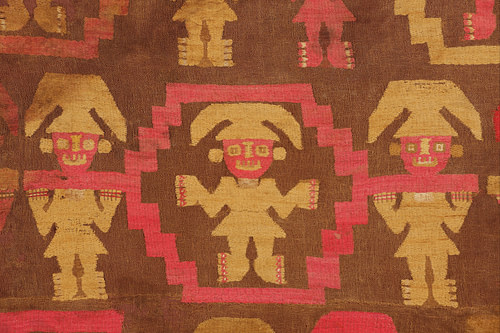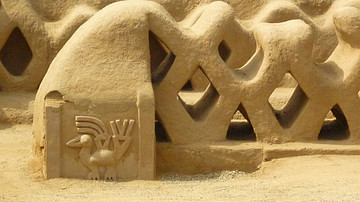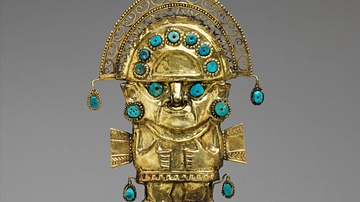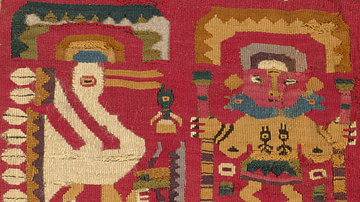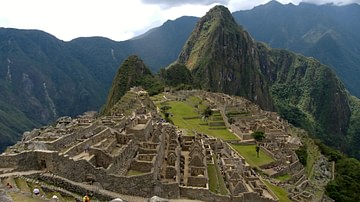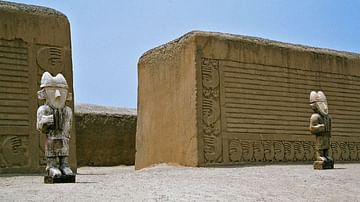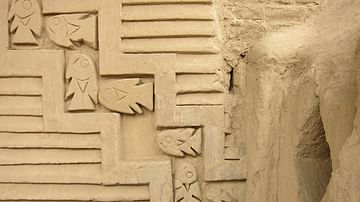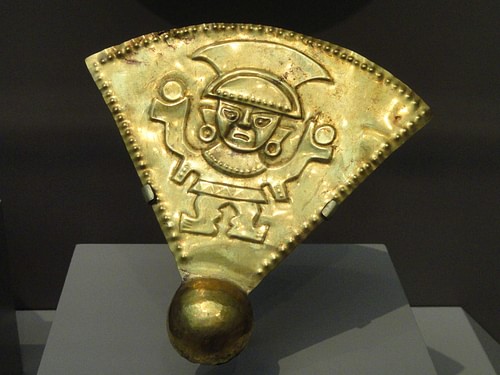
The Chimu Civilization, otherwise called the kingdom of Chimor, flourished on the northern coast of Peru between the 12th and 15th centuries CE. With their capital at Chan Chan, the Chimu were the largest and most prosperous culture in the Late Intermediate Period and forged the second-largest empire in the history of the ancient Andes. Their architecture, approach to regional governance, and art would also go on to influence their more famous successors, the Incas.
Historical Overview
The traditional founding ruler of the Chimú was Taycanamo who was considered to have been born from a golden egg and then arrived from the sea. Other notable rulers include Guacricaur, who expanded into the Moche, Santa, and Zaña valleys. Eventually, the Chimú extended their territory even further south and in 1375 CE, under the rulership of Nancinpinco, conquered the Lambayeque (Sicán) culture absorbing some of their cultural practices and artistic ideas. The La Leche Valley was also brought under Chimú control so that, at its height during the reign of Minchançaman c. 1400 CE, the area of Chimú influence stretched 1300 km along the coast of northern Peru.
The initial prosperity of the Chimú was largely due to their agricultural skills as they built an extensive irrigation system using canals. Later, their successful military campaigns and policy of extracting tribute ensured that they became the dominant regional power. Chan Chan came to be the capital of other administrative centres, such as at Farfán, Manchan, El Milagro, Quebrado Katuay, and the fortress site of Paramonga. This domination came to an end with the rise of the Incas who, led by Tupac Yupanqui, captured the 11th known Chimú ruler Minchançaman c. 1470 CE. Thereafter, the Chimú became a vassal state in the Inca Empire, and their king was kept permanent prisoner at Cuzco to ensure compliance to the new order. The Incas also assimilated certain aspects of Chimú culture, such as rulers inheriting the title but not the property of their predecessors, the policy of allowing conquered rulers a certain autonomy, the idea to have compounds of foreign artists working for the state, and certain features of Chimú art. The Incas also kept records of the Chimú culture, and through these, we have, albeit sparse, information regarding their rulers and principal gods. The latter include the creator god Ai Apaec, the sea god Ni, and, perhaps the most important deity in the Chimú pantheon, the moon goddess Si.
Chan Chan
The capital city of the Chimú was Chan Chan (known as Chimor to its original inhabitants) which, built at the mouth of the Rió Moche, covered some 20 square kilometres and had a population of up to 40,000 at its peak. The city became the hub of a vast trade and tribute network, and no fewer than 26,000 craftsmen and women resided there, often forcibly removed from conquered cities to mass-produce high-quality goods in a wide range of precious materials.
Chimú architecture is characterised by monumental adobe brick buildings. Ten royal palaces or compounds were constructed over the centuries in a rectangular layout, each with 10-metre high double exterior walls, labyrinthine interiors, and with only a single entrance. Of special note are the U-shaped audience rooms which controlled access to the storerooms. The walls of the compounds, built to restrict access by commoners, were decorated on the inside with bold relief designs, typically repeated geometric shapes, animals, and sea life, especially fish. The cut patterns may have been in imitation of those from textile wall hangings. Similar adobe compounds were built at other Chimú sites, for example, nine at Manchan and six at Farfán.
Functional structures within each compound include administrative and storage buildings and burial platforms accessed by ramps which contained mummified leaders. Over time the newer palaces became larger - the biggest covers an area of 220,000 square metres - and more space was dedicated to storage, indicative of the Chimú's policy of extracting tribute from conquered territories. Chan Chan also expanded in general with more residences for administrators and artisans, the latter living in modest dwellings of wattle-and-daub with steep roofs and a single hearth. The city also had an extensive irrigation system which combined canals, shallow reservoirs, and wells.
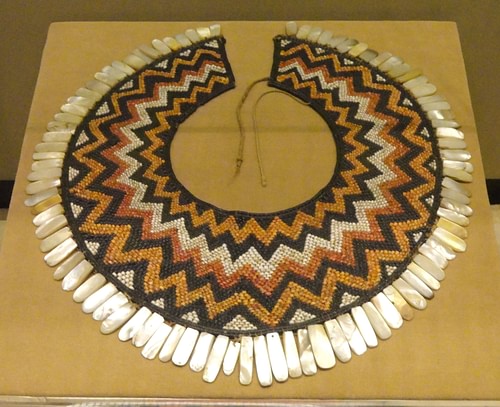
Chimú Art
Influenced by the Wari and Moche civilizations, the Chimú would continue and expand upon artistic themes which have become staple features of Andean art ever since. Chimú pottery is characterised by mould-made blackware and redware with sculpted decoration which is given a highly polished finish. The most common shape is double-spouted bulbous jars. Textiles have natural colours, the most precious with exotic feather decoration where plumes are sown in rows onto a cotton backing and dyed to create designs. Popular motifs include open-armed figures wearing headdresses - probably representing the ruling class - and double-headed 'rainbow' snakes. Textiles could also be decorated with precious metal additions and one tunic survives with 7,000 small gold squares individually sewn onto the fabric.
Carved and inlaid spondylus shells, acquired from Ecuador, were another popular medium for Chimú art with diamond-shape inlays creating striking jewellery pieces. Precious goods could also be made using gold, silver, and imported amber and emeralds from Colombia. Many examples of wooden sculptures have been recovered from two pyramid structures outside Chan Chan (Huaca el Dragón and Huaca Tacaynamo). Most such figures represent members of funerary processions.
Finally, it is interesting to note that Chimú rulers were themselves collectors of art from other cultures and their palaces were full of niches in which objects and statues were placed for display. Chan Chan artists themselves had such a reputation that the Incas forcibly relocated thousands of them, along with their finest pieces, to their capital at Cuzco, which was also an effective method to control precious goods production and so limit the resources to fund a rebellion.
